Study of the Overlying Strata Movement Law for Paste-Filling Longwall Fully Mechanized in Gaohe Coal Mine
Abstract
:1. Introduction
2. Engineering Background
3. Mechanical Analysis of Overlying Rock Movement of the Filled Working Face
3.1. Stress Model of Paste-Filling Working Face
3.2. Analysis of the Roof Subsidence Law of the Filled Working Face
- (1)
- The calculation model of the deflection generated by the volume weight of the roof strata can be simplified (see Figure 4a). The rock beam bends due to its volume weight, and the deflection curve formula of the beam is obtained by the integral method, as follows:

- (2)
- The supporting load of the filling hydraulic support on the roof is based on the triangular load in the filling working face. The front of the triangular load has an appropriate unsupported roof distance. Figure 4b shows the mechanical model. Actual paste-filling working face support has a supporting function, and the overlying roof no longer sinks. Errors will occur if the actual support load on the roof is used to calculate the roof deflection curve. Therefore, the equivalent supporting force of the self-weight load of the overlying strata is set in the supporting area. This is to simulate the supporting force of the support on the roof. The two can offset the influence of force relatively without changing the structural form of the beam. Figure 4c presents a mechanical model.
- (3)
- The supporting force of the filling body on the roof strata is considered a uniform load. Figure 4d lists the mechanical model and a = d + 0.5c. The supporting force generated by the two ends of the beam is as follows.
- (4)
- The model can be simplified when the paste-filling working face advances for a long distance. The supporting force of each filling body on the roof is assumed to be the concentrated force from the uniform load set previously. Figure 4e presents the force model. The equation of the beam deflection curve obtained by the integral method is as follows:
4. Numerical Simulation of Overlying Strata Movement in the Filled Working Face
4.1. Research of Stress Distribution Law of Filling Working Face
4.2. Research on the Movement Law of Overburden Rock in Filling Face
5. Analysis of the Main Influencing Factors of Overlying Rock Movement in Filling Working Face
5.1. Analysis of the Filling Rate
5.2. Analysis of the Filling Step Distance
5.3. Analysis of the Compression Amount of the Filling Body
6. Earth Surface Subsidence Law in Filling Mining
6.1. Actual Measurement of Earth Surface Subsidence
6.2. Law of Earth Surface Subsidence
7. Conclusions
- (1)
- The deflection formula for the roof behind the paste-filling face can be represented by a unified quartic equation. The significant factors that influence the substantial subsidence of the roof in the filling face include the step distance of the face during filling, the strength of the filling material, the filling rate, and other associated parameters;
- (2)
- Numerical simulation studies have revealed significant differences between filling mining and traditional caving mining in terms of stress concentration, stress influence range, and overlying rock deformation. Filling mining exhibits a considerably lower degree of stress concentration in the surrounding rock, a reduced range of stress influence, and gentler deformation of the overlying rock compared to caving mining. The subsidence coefficient in filling mining is approximately one-tenth of that in caving mining. The development of cracks in filling mining can be categorized into three stages: initial crack formation, subsequent compaction of cracks, and stable maintenance of cracks. The initial crack development follows a “sail-shaped” progression. The compaction of cracks occurs predominantly above the back of the cutting hole, while cracks behind the working face are limited to the uppermost rock layer;
- (3)
- Based on on-site measurements, it was observed that the filling rate of the longwall fully mechanized mining paste filling had exceeded 94%. In this high filling rate, the top plate of the filling working face remains intact and exhibits a bent and sunken state. The subsidence of the roof demonstrates an exponential increase as the filling step distance increases. Additionally, it follows a pattern of initial increase followed by regional stability as the empty roof time progresses. Notably, approximately 80% of the deformation of the filling material occurs within a 20 m range immediately after the filling process;
- (4)
- Through field measurements and analysis of surface subsidence, it was observed that the stability period of the overlying rock in paste-filling mining is considerably shorter compared to caving mining. The movement of the overlying rock is relatively gentle, without an active period of surface movement. Approximately six months after filling, the overlying rock reaches a state of stability, with a subsidence coefficient of 0.065. The maximum surface subsidence measures 215 mm, the maximum inclined deformation is 1.4 mm/m, the horizontal deformation ranges from −0.7 mm/m to 0.7 mm/m, and the maximum curvature ranges from −0.03 mm/m2 to 0.03 mm/m2. The deformation of surface buildings remains within 50% of the allowable value for Class I damage, indicating that the control of surface subsidence through paste-filling mining \ achieved favorable outcomes. These research findings serve as an effective theoretical foundation and research direction for predicting overburden movement and surface subsidence in paste-filling operations. Moreover, they contribute to the comprehensive application of paste filling in mines across China, offering valuable guidance for the environmentally friendly construction of mining operations.
Author Contributions
Funding
Institutional Review Board Statement
Informed Consent Statement
Data Availability Statement
Acknowledgments
Conflicts of Interest
References
- Niu, J.; Zhang, X.J.; Han, K. Design of Mining Three-UnderPressure Coal and Optimization of Numerical Simulation in Baivuan Mine. Min. Res. Dev. 2022, 42, 13–19. [Google Scholar]
- Xiao, J.J.; Li, S.; Yang, X.G. Study on Technology of Coal Mining under Building Replacing by Original Gangue. Coal Technol. 2022, 41, 12–16. [Google Scholar]
- Qian, M.G. On sustainable coal mining in China. J. China Coal Soc. 2010, 35, 529–534. [Google Scholar]
- Wang, J.C.; Liu, F.; Wang, L. Sustainable coal mining and mining sciences. J. China Coal Soc. 2016, 41, 2651–2660. [Google Scholar]
- Sun, X.K. Present situation and prospect of green backfill mining in mines. Coal Sci. Technol. 2020, 48, 48–55. [Google Scholar]
- Miao, X.X.; Zhang, J.X.; Guo, G.L. Study on waste-filling method and technology in fully-mechanized coal mining. J. China Coal Soc. 2010, 35, 1–6. [Google Scholar]
- Miao, X.X.; Ju, F.; Huang, Y.L. New development and prospect of backfilling mining theory and technology. J. China Univ. Min. Technol. 2015, 44, 391–399, 429. [Google Scholar]
- Feng, G.M.; Jia, K.J.; Shang, B.B. Application and prospect of super-high-water packing material in mining engineering. Coal Sci. Technol. 2015, 43, 5–9. [Google Scholar]
- Qian, M.G.; Xu, J.L.; Miao, X.X. Green Technique in Coal Mining. J. China Univ. Min. Technol. 2003, 32, 343–348. [Google Scholar]
- Sun, X.K. Research on paste backfilling mining technology of coal mining under buildings, water bodies and railways. Coal Sci. Technol. 2021, 49, 218–224. [Google Scholar]
- Tian, M.F. Application and Development of Mining Engineering Filling Technology. West. Resour. 2022, 3, 101–103. [Google Scholar]
- Liu, J.G.; Wang, H.Q.; Zhao, J.W. Review and prospect of development of solid backfill technology in coal mine. Coal Sci. Technol. 2020, 48, 27–38. [Google Scholar]
- Zhou, H.Q.; Hou, C.J.; Sun, X.K. Solid Waste Paste Filling for None-Village-Relocation Coal Mining. J. China Univ. Min. Technol. 2004, 33, 154–158. [Google Scholar]
- Chen, S.J.; Guo, W.J.; Zhou, H. Structure model and movement law of overburden during strip pillar mining backfill with cream-body. J. China Coal Soc. 2011, 36, 1081–1086. [Google Scholar]
- Wen, G.H.; Li, X.S.; Pu, Z.Q. Study on the law of o-verburden movement during isolated coal pillar mining with paste filling. J. Shandong Univ. Sci. Technol. (Nat. Sci.) 2010, 29, 46–50. [Google Scholar]
- Sun, X.K.; Li, X.S.; Shi, X.Y. Study on mine strata behavior with full backfill effect of paste backfill in coal mine. Coal Sci. Technol. 2017, 45, 48–53. [Google Scholar]
- Qu, Q.D. The Theory and Practice of Strata Control City Goaf Paste Backfilling; China University of Mining and Technology: Beijing, China, 2007. [Google Scholar]
- Chang, Q.L. Research on Theory and Practice of Mining Induced Overlying Strata Deformation and Surface Subsidence with Paste Backfilling; China University of Mining and Technology: Beijing, China, 2009. [Google Scholar]
- Guo, Z.H. Study on Surface Subsidence with Paste Filling under Village; China University of Mining and Technology: Beijing, China, 2008. [Google Scholar]
- Liu, T.Y.; Cai, S.J. Status quo of application and research of paste fill technology in China and abroad. China Min. Mag. 1998, 7, 1–4. [Google Scholar]
- Han, W.J.; Song, G.Y.; Cao, Z. Study on the Law of Strata Movement Isolated Coal Pillar Mining with Paste Filling. Saf. Coal Mines 2013, 44, 220–223. [Google Scholar]
- Chang, Q.L.; Zhou, H.Q.; Bai, J.B. Stability Study and Practice of Overlying Strata with Paste Backfilling. J. Min. Saf. Eng. 2011, 28, 279–282. [Google Scholar]
- Song, G.Y. Study on overlying stratasubsidence law for paste backfill conventional coal mining. Coal Sci. Technol. 2021, 49, 317–321. [Google Scholar]
- Hu, B.N.; Zhang, H.X.; Shen, B.H. Guidelines for Coal Pillar Reservation and Coal Mining under Pressure in Buildings, Water Bodies, Railways and Main Shafts; China Coal Industry Publishing House: Beijing, China, 2017. [Google Scholar]
- Sun, X.G.; Zhou, H.Q.; Wang, G.W. Digital simulation of strata control by solid waste paste-like body for backfilling. J. Min. Saf. Eng. 2007, 24, 117–121. [Google Scholar]
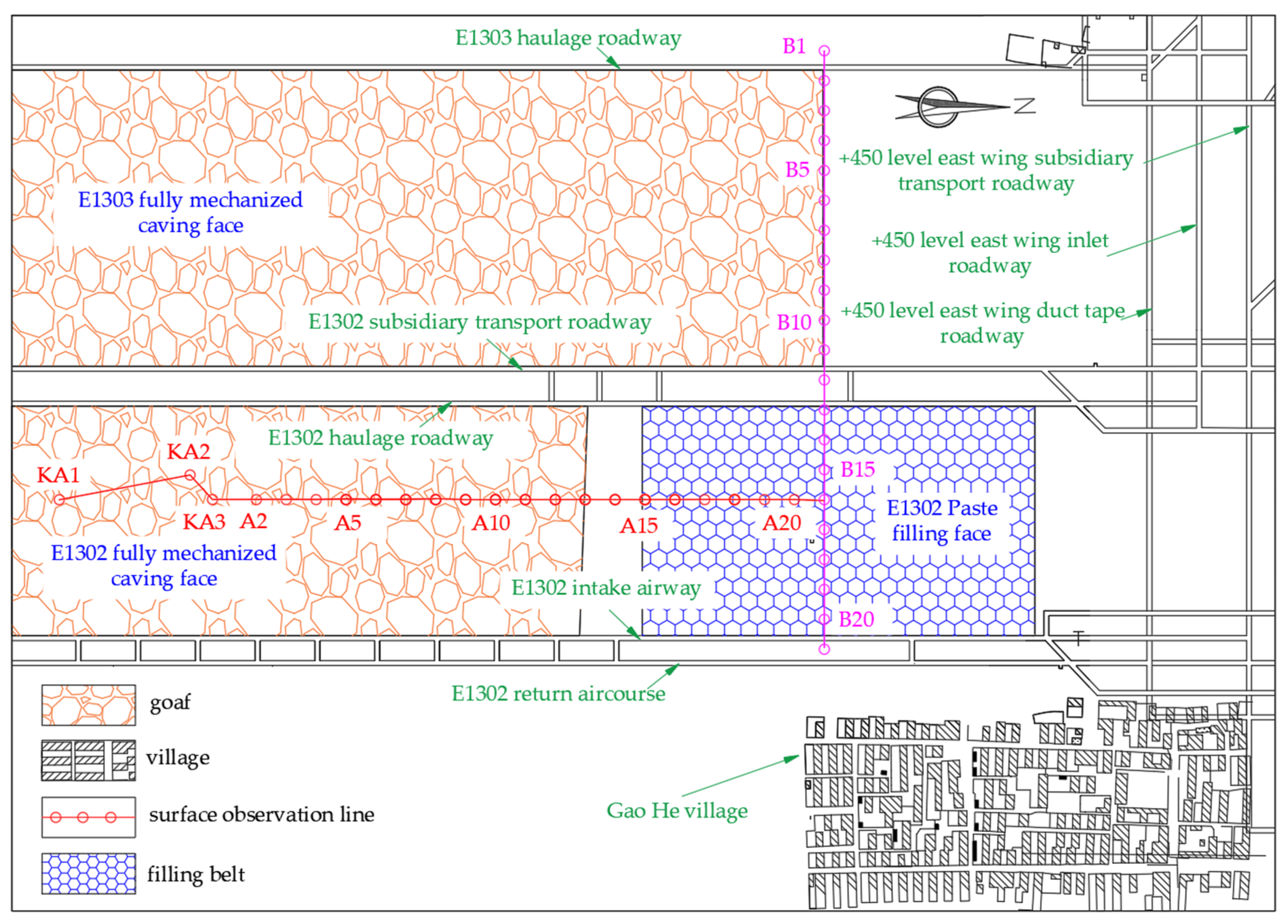


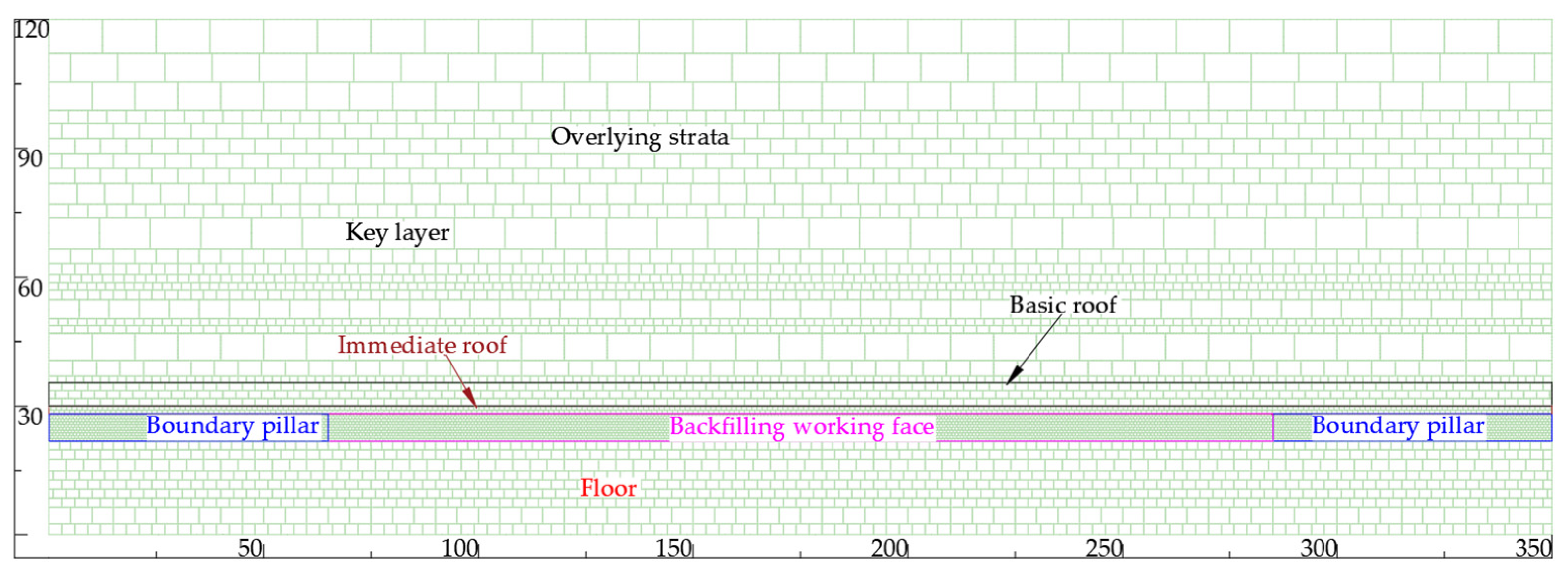






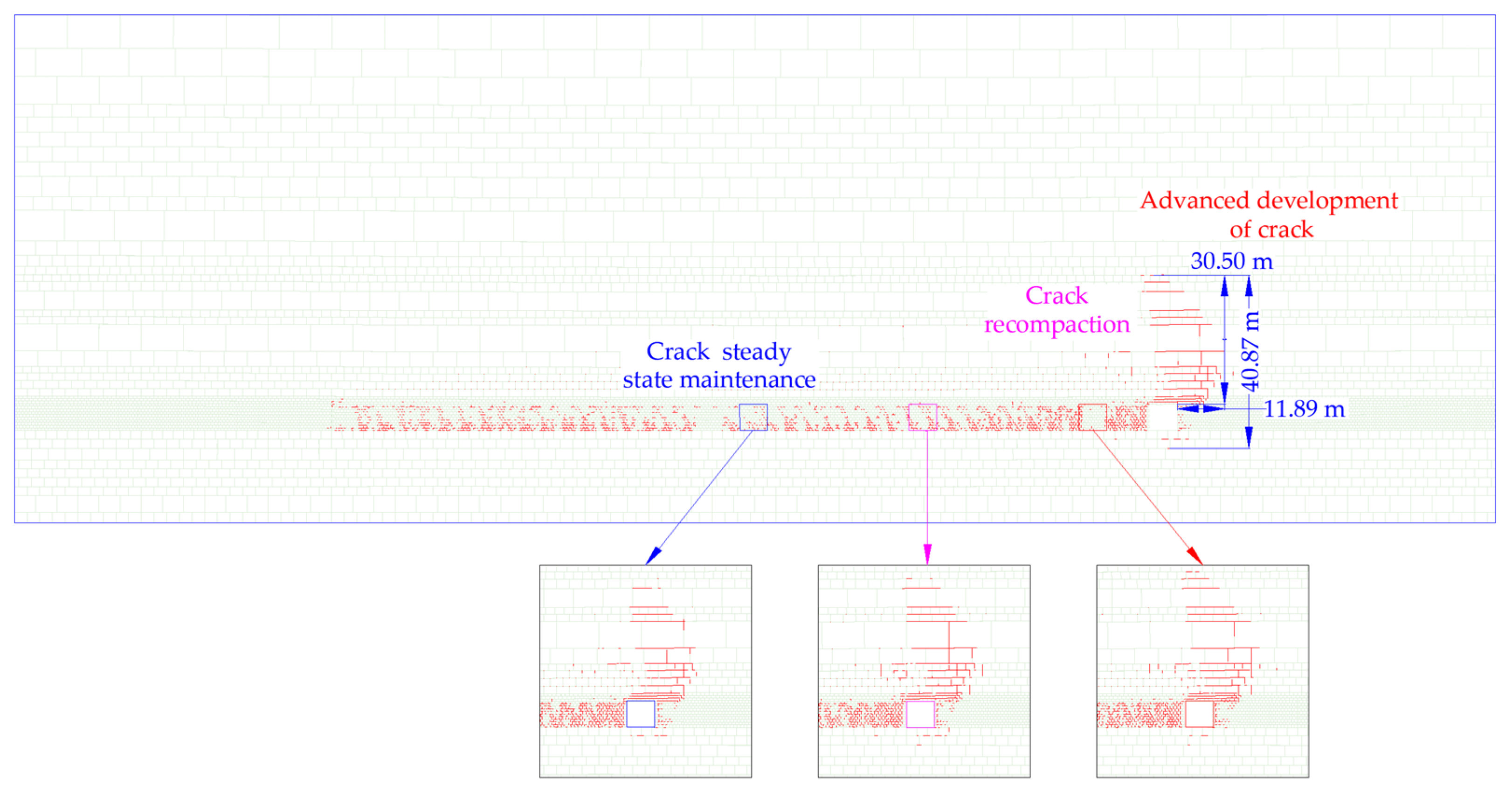


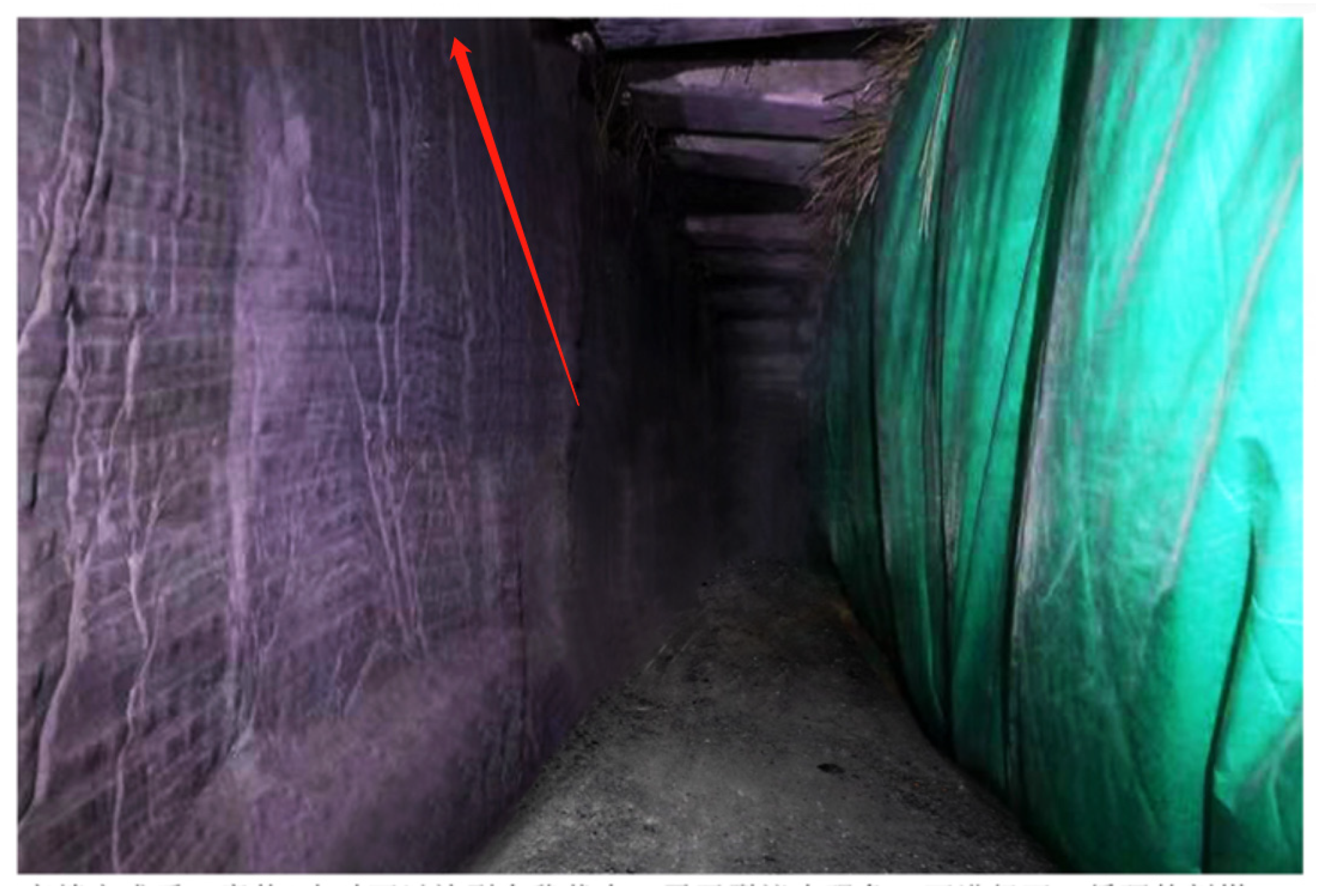
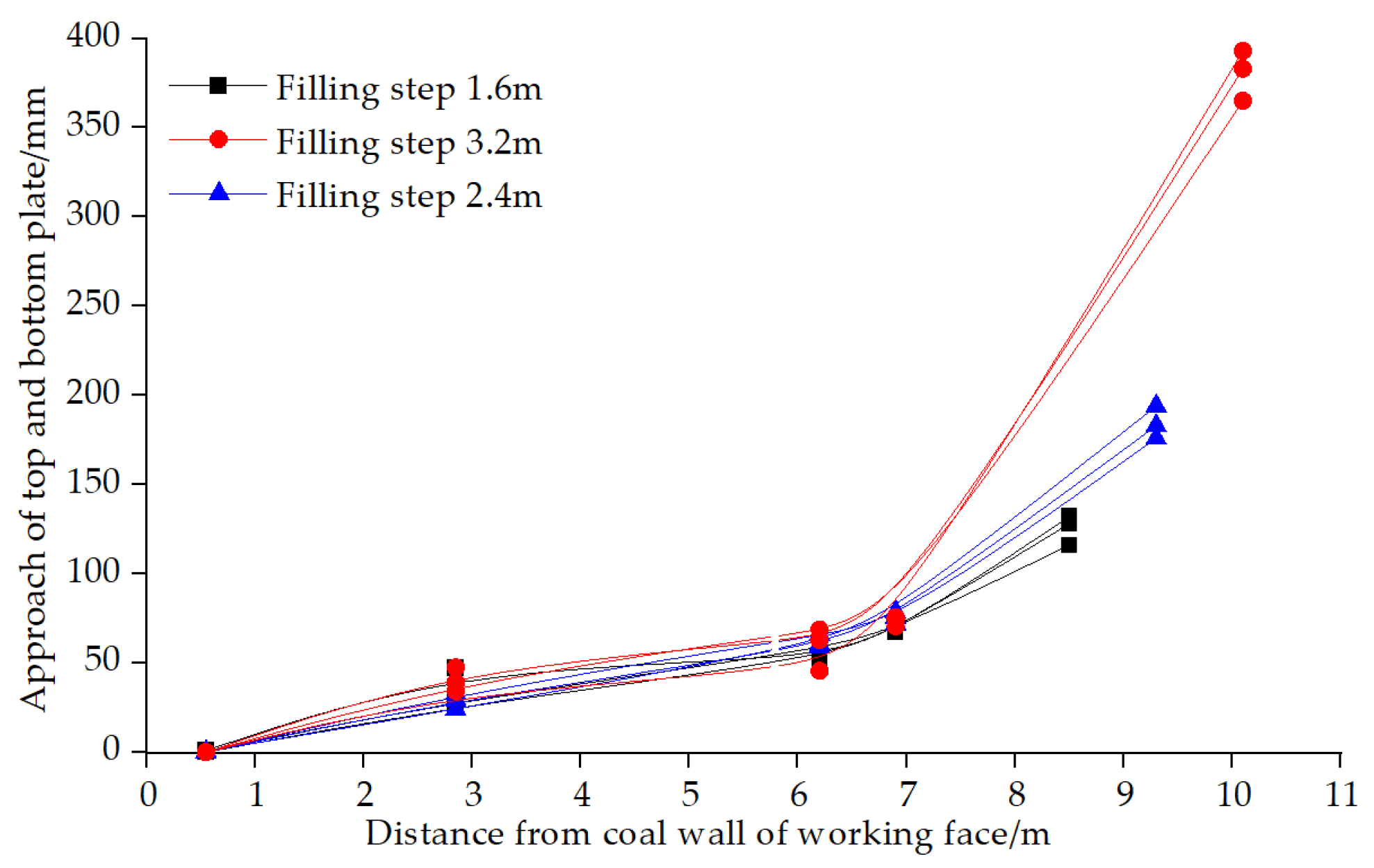

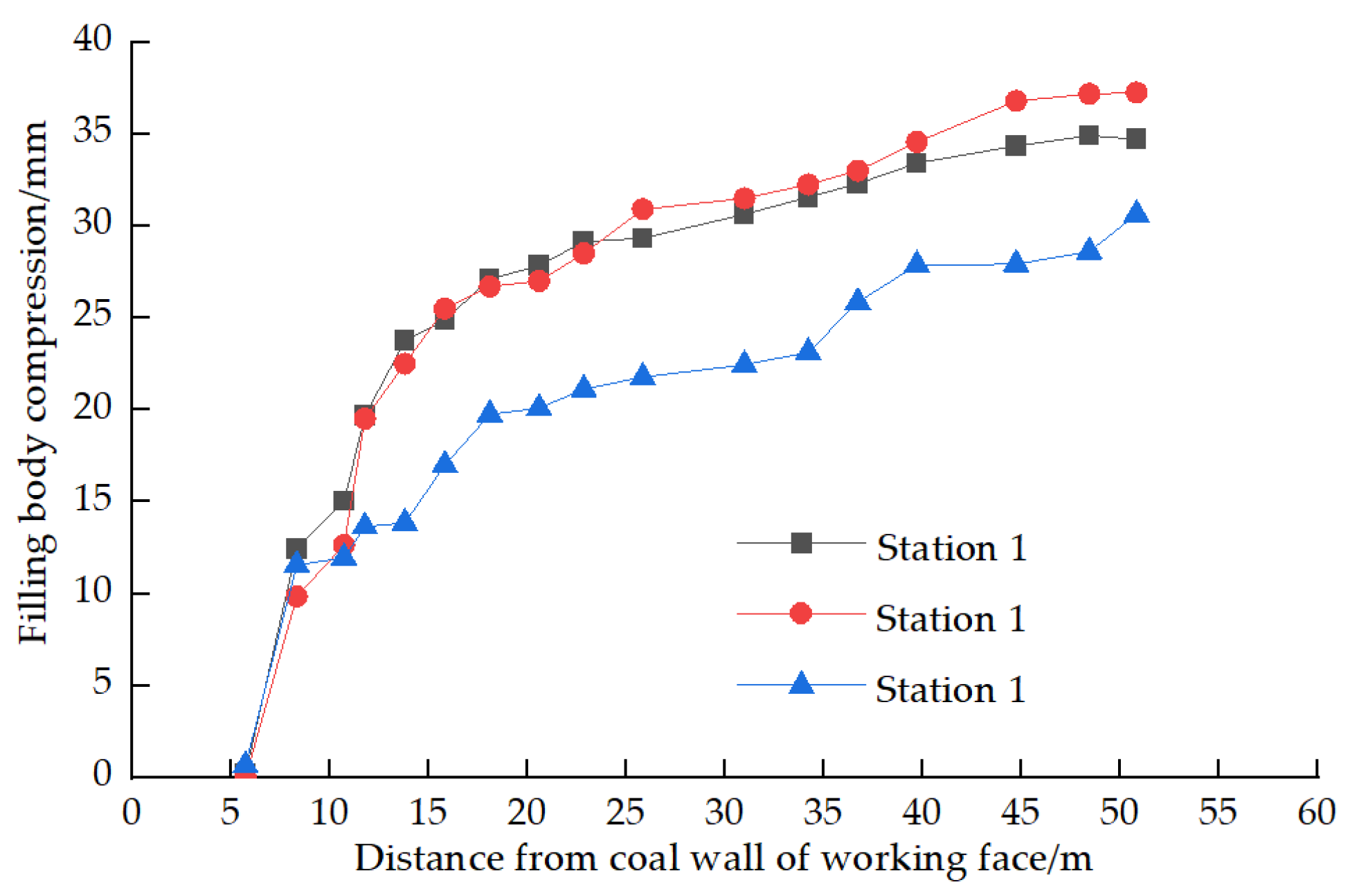

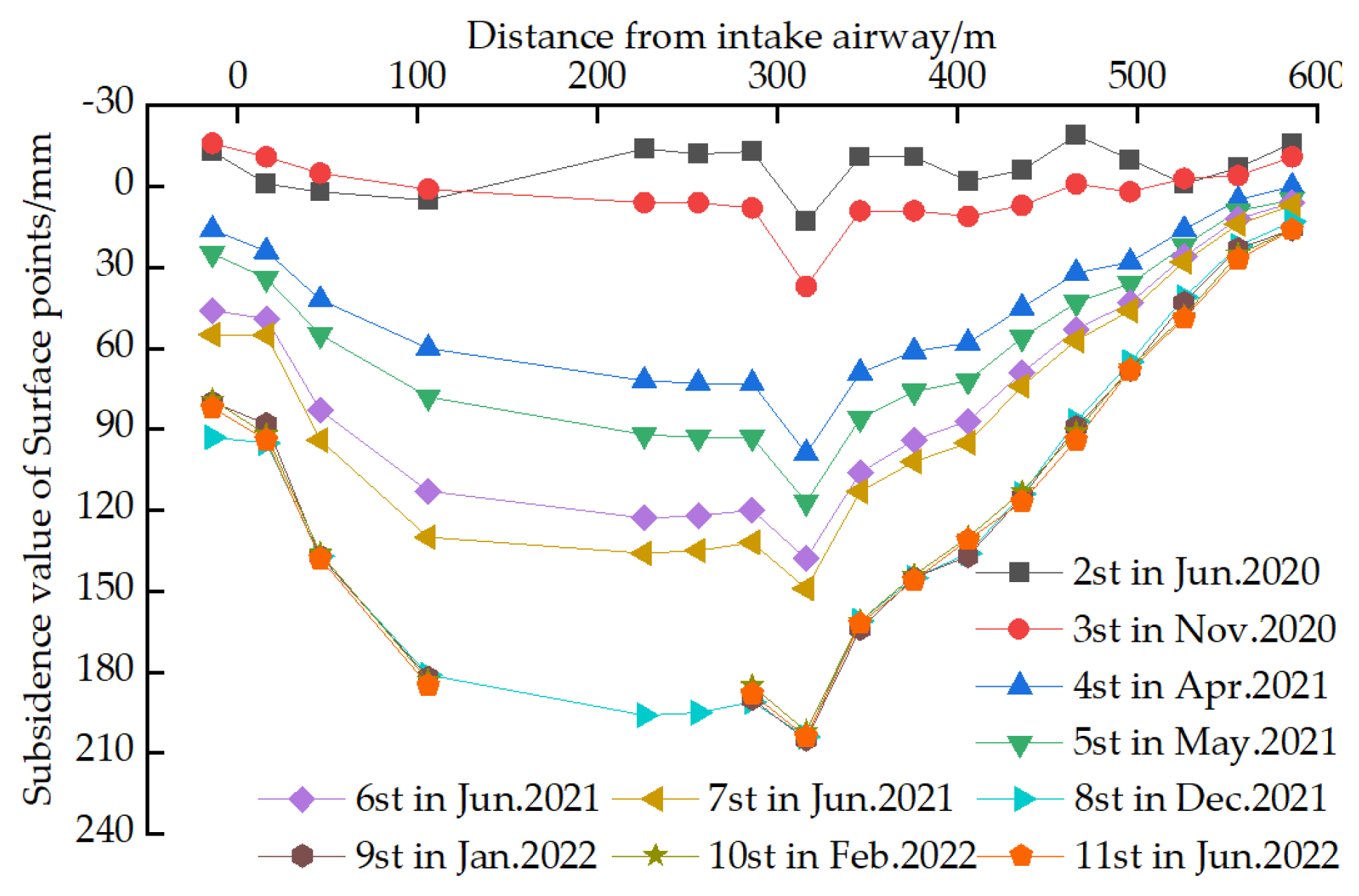
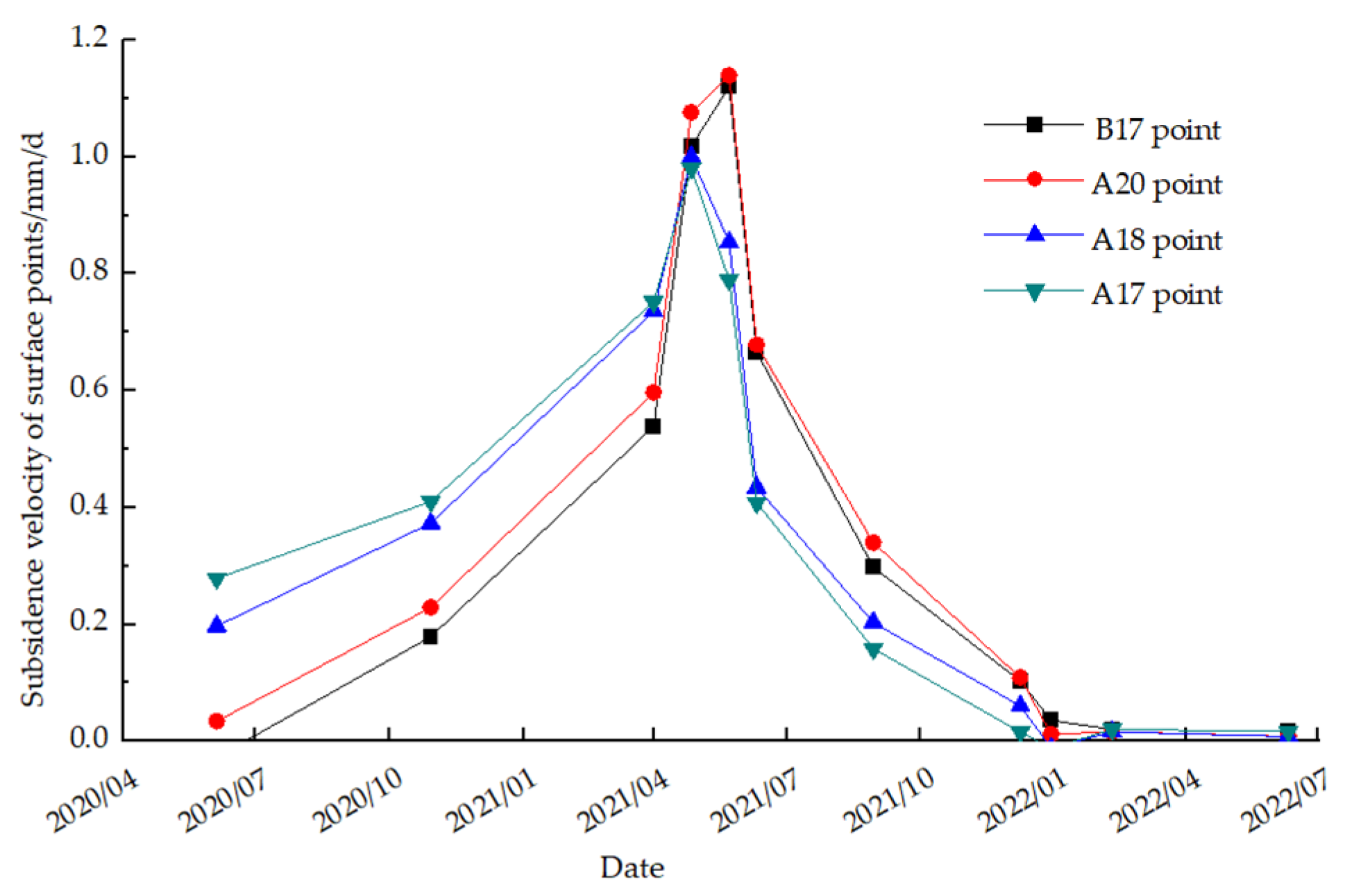

Disclaimer/Publisher’s Note: The statements, opinions and data contained in all publications are solely those of the individual author(s) and contributor(s) and not of MDPI and/or the editor(s). MDPI and/or the editor(s) disclaim responsibility for any injury to people or property resulting from any ideas, methods, instructions or products referred to in the content. |
© 2023 by the authors. Licensee MDPI, Basel, Switzerland. This article is an open access article distributed under the terms and conditions of the Creative Commons Attribution (CC BY) license (https://creativecommons.org/licenses/by/4.0/).
Share and Cite
Song, G.; Du, K.; Zhang, Y.; Li, Z.; Hu, L. Study of the Overlying Strata Movement Law for Paste-Filling Longwall Fully Mechanized in Gaohe Coal Mine. Appl. Sci. 2023, 13, 8017. https://doi.org/10.3390/app13148017
Song G, Du K, Zhang Y, Li Z, Hu L. Study of the Overlying Strata Movement Law for Paste-Filling Longwall Fully Mechanized in Gaohe Coal Mine. Applied Sciences. 2023; 13(14):8017. https://doi.org/10.3390/app13148017
Chicago/Turabian StyleSong, Guangyuan, Kai Du, Yidong Zhang, Zexin Li, and Lei Hu. 2023. "Study of the Overlying Strata Movement Law for Paste-Filling Longwall Fully Mechanized in Gaohe Coal Mine" Applied Sciences 13, no. 14: 8017. https://doi.org/10.3390/app13148017
APA StyleSong, G., Du, K., Zhang, Y., Li, Z., & Hu, L. (2023). Study of the Overlying Strata Movement Law for Paste-Filling Longwall Fully Mechanized in Gaohe Coal Mine. Applied Sciences, 13(14), 8017. https://doi.org/10.3390/app13148017




